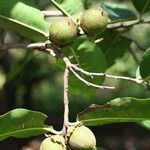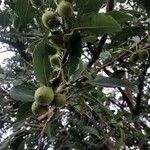Evergreen trees or shrubs up to 25 m high but usually smaller, trunk up to 1.5 m in diam., bark blackish grey, rough and fissured; branchlets and inflorescence tawny to ferruginous-pubescent. Leaves alternate, elliptic-oblong, obovate-oblong to oblanceolate-oblong, coriaceous, sparsely sericeous below or glabrescent, with a dull gloss above, 4.5-14 cm long and 1-3 cm wide, usually about 8 x 2.5-3 cm, apex obtuse to acute with a rounded tip, base broadly cuneate to rounded and often somewhat unequal. Male flowers sessile, 3 to many together in small pedunculate axillary cymes, tetramerous or pentamerous. Calyx lobed about halfway down, hairy, lobes ovate to lanceolate. Corolla narrowly urceolate, shortly lobed, densely sericeous. Stamens 10-16, often in pairs, filaments short, ovary rudimentary, hairy. Female flowers 4-5-merous (calyx rather frequently 4 lobed), solitary, shortly pedicellate in axils of the leaves or from below old leaf scars on second years growth; bracts 2, caducous. Calyx lobed rather more than halfway down, ferruginously sericeous, tomentose outside; lobes cordate acuminate and undulate plicate towards the base. Corolla 1-1.2 cm long, urceolate, hairy outside. Staminodes about 7. Ovary densely pubescent 4-8 celled, with a single pendulous ovule in each cell. Disc fleshy, small, glabrous. Fruit subglobose yellowish to greenish, glabrescent; fruiting calyx with undulate lobes, about 1/3 the length of the fruit. Seeds 2-4, oblong, compressed, pale to dark brown, testa verruculose, glossy; endosperm somewhat ruminate near the testa.
Usually a medium-sized tree 10-15 m in height, occasionally reaching 25 m, with a dense dark rounded crown, giving excellent shade, or sometimes flowering as a shrub at only 3 m. Bark: dark blackish grey, rough, with deep longitudinal furrows; young branchlets, growing tips and young leaves pinkish. Leaves: alternate, oblong-elliptic or oblanceolate-elliptic, 4.5-14 x 1-4.5 cm, glossy dark green above, rather paler green below, turning yellow in autumn, almost hairless, 15-20 pairs of lateral veins ascending at about 45 degrees to the midrib, indistinct or slightly prominent below; apex broadly tapering to rounded; base tapering, sometimes square; margin entire, frequently closely wavy; petiole up to 1 cm long. Flowers: up to 1.2 cm long, cream to pale yellow, creamy grey hairs on the calyx and flower stalks, solitary in the axils of the leaves; floral parts in 4s or 5s (Oct./Nov.). Fruit: ovoid to almost round, fleshy, up to 2.5 cm in diameter, with very short soft hairs when young, losing these by maturity and becoming hard-skinned and yellow to purplish, persistent calyx with 4 or 5 wavy lobes covering less than a third of the fruit, the tips then curling back and not fully clasping it (Apr.-Sept.). Seeds: 3-6, reddish brown, mottled.
An evergreen tree. It grows up to 15-20 m tall. It can grow to 45 m tall in forests. It has a dense wide spreading round crown. The trunk sometimes has buttresses. Young branches have soft hairs. The bark is dark grey. The bark is smooth in young trees and becomes rough in older trees. The small twigs are pink. The leaves are simple. They are 4-17 cm long and 1.5-5.5 cm wide. The midrib is sunken on top and prominent underneath. The flowers occur as male and female flowers on separate trees. The male flowers occur in clusters and the female flowers occur singly. The fruit are round and 3 cm across. They have sweet edible pulp. The fruit are green and with hairs when young and become yellow or purple when ripe. They contain 4-6 seeds. The seeds are brown. They are oblong and flattened.
Leaves subcoriaceous, old leaves drying dull grey–green above and yellowish–green beneath, young leaves drying pale reddish–brown; lamina 6 x 2·2–14 x 4·5 cm., mostly oblong–elliptic or oblanceolate–elliptic; apex usually acute to subacuminate, rarely obtuse or rounded; base cuneate or rounded; lower surface minutely puberulous with appressed strigulose hairs or spreading flexuose hairs; lateral nerves in 15–20 pairs, ascending at 45°, indistinct, together with the tertiary nerves and veins forming a reticulum which is slightly prominent on both surfaces.
Evergreen tree or shrub, up to 25 m high. Growth points sickle-shaped. Flowers tetra-or pentamerous. Male flowers sessile, 3 to many together in small pedunculate axillary cymes. Female flowers solitary, shortly pedicellate. Calyx lobes of female flowers undulate-plicate near base, sericeous-tomentose outside, cordate-acuminate. Flowers green, white or cream.
Male flowers sub–sessile in 3s at the end of 0·4–0·6 cm. long peduncles arising from the axils of caducous reduced leaves at the base of the current year’s growth or of the first–formed normal leaves.
Stamens c. 14, included, 0·4 cm. long; filaments 0·1 cm. long, glabrous, inserted on the receptacle; anthers narrowly lanceolate, apiculate, glabrous, except for a few short hairs on the connective.
Corolla 0–6 cm. long, narrowly urceolate, sericeous–tomentose outside; tube 0·5 cm. long, glabrous inside and thickened at the throat; lobes 4–5, deltate, 0·1 cm. long.
Fruit up to 2·5 cm. in diameter, yellow, globose, verruculose, glabrescent, but a few hairs persisting near the base of the persistent style.
Female flowers subsessile, solitary, or rarely 2–3 together, in the axils of reduced leaves at the base of the current year’s shoot.
Calyx and corolla similar to the male but calyx 0–8 cm. long and lobes cordate–deltate with undulate–plicate reflexed margins.
Ovary 0·3 cm. in diameter; style scarcely differentiated from the ovary; stigma sessile; locules 4 or 6.
Fruiting calyx patelliform or shallowly cyathiform, lobes with recurved, strongly undulate margins.
Bark dark brown or black, rough, longitudinally fissured, exfoliating in square scales.
Evergreen tree up to 25 m. high or more, rarely flowering as a shrub c. 3 m. high.
Staminodes 6–12, filiform, 0·4 cm. long, glabrous, inserted at base of corolla.
Young branchlets tomentellous with pinkish appressed hairs, glabrescent.
Calyx 0–3 cm. long, lobes 4–5, deltate, 0·15 cm. long.
Seeds 3–6, reddish–brown; endosperm deeply ruminate.
Bark rough, dark brown or black, muricate
Forest and savanna tree up to 90 ft. high
Bole sometimes fluted at the base.
Slash black outside, pink inside
Pistillode minute, tomentose.
Flowers white, sweet-scented
Corolla 1–1·2 cm. long.
Crown dense, rounded.
Fruit yellowish.





